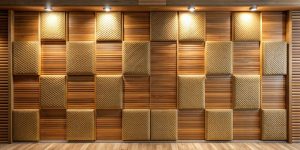Decorative Acoustic Panels: Form and Function
There were days when acoustic panels got a bad rap. People saw them as foam egg cartons tacked to the walls of recording studios. We thought they offered little in the way of design. They served a purpose, and that’s it. As their use cases evolved, so did the styles. We now have decorative acoustic panels that are available in every color under the sun. Not only that, but their shapes have evolved to make them go-to acoustic solutions for every room. We see them everywhere, from high end office buildings to our local eateries.
The reason they have evolved so rapidly is that they provide the perfect combination of form and function. We now use acoustic panels in every type of space to improve the aesthetics as well as the acoustics. Let’s take a look at how this seemingly niche product became a staple of modern design.
What are Decorative Acoustic Panels?
At their cores, decorative acoustic panels are dense, porous materials that trap sound waves. The porous surface allows sound waves in, and the dense interior holds them there. They are incredibly effective against a range of audio frequencies and help to prevent audio issues.
All that said, it makes sense why we associated them with recording and entertainment spaces for so long. If we weren’t banging on drums in our living rooms, what use did we have for them?
Well, it turns out acoustical issues are just as annoying in the boardroom as they are in the recording studio. Poor acoustics can cause communication problems in our homes, offices, and entertainment venues. Here’s why.
Echo and Reverb: Communication Killers
When sound waves are allowed to run rampant, they cause acoustical anomalies that make clear communication more difficult. The most common of these audio issues are echo and reverb. They are different but related concepts that have big impacts on the way a room sounds.
Echo
We’re all familiar with echo. A sound wave travels across an expanse, reflects off a hard surface, and returns to us. We hear the same sound that was just produced a few moments later. It’s a fun science experiment, but not so fun when we rely on peaceful ambiance. Whether that’s because we need to relax or communicate, echo can cause major disturbances. It needs to be addressed if we want our rooms to sound great.
Reverb
Reverberation, or reverb, is another common issue that affects a room’s sound. When reflected sound waves bounce back and forth for a while, they begin to multiply and intensify in volume. As we continue to talk and move in the space, we add more and more sound waves. If they’ve got nowhere to go, they begin to collect and amplify. Trapping and scattering sound waves are the keys to eliminating both echo and reverb. We scatter sound waves with diffusers, and we trap them with acoustical panels.
How Do Poor Acoustics Impact Us?
We’ve touched on some of the culprits that make for bad acoustics but not how they affect us. In short, acoustical issues cause a host of problems. They can make communication more difficult, raise stress levels, and even contribute to hearing loss.
Echo and reverb make communication more difficult by contributing unwanted noise and raising the volume of that noise. When our words compete with lingering sounds, they make it harder for our friends and family to hear. We generally speak louder to compensate, which only exacerbates the problem.
It doesn’t end with communication problems. When we’re regularly exposed to an abundance of noise, it has negative effects on our mental health. Studies have shown that this kind of exposure can raise our stress levels and blood pressure. It can also cause problems with concentration and focus. The longer and louder that exposure, the more the impact rolls over into physical issues.
At higher levels, that excess noise can contribute to hearing loss. Prolonged exposure to levels above 70 decibels can begin to cause hearing damage. That’s about the volume of the washing machine in a residential home. As those levels increase, so do our chances of experiencing hearing loss. Absorbing noise before it becomes a nuisance is key to protecting ourselves.
The Rise of Decorative Acoustic Panels
As we’ve come to terms with the impact of noise on our health, we’ve created attractive ways to combat it. Decorative acoustic panels are now among the most popular ways to improve interior acoustics and reduce noise levels. With that kind of demand, engineers have come up with ingenious ways to incorporate them into all kinds of spaces. Let’s look at some creative ways we use decorative acoustic panels to create more serene spaces.
Popular Uses of Decorative Acoustic Panels
When it comes to acoustic panels, design ideas are plentiful. They’re a versatile material that can be shaped and designed in nearly any way we want. We can mount them to surfaces, suspend them from ceilings, or place them throughout the room as an acoustic column. We can use them to improve the look and sound of nearly any space we inhabit. Let’s explore the different ways we can leverage them in the rooms we love.
Create Great Accents for Any Space
A simple way to break up monotony and incorporate acoustical benefits is with a soundproof accent wall. Lining a wall with panels can create a patchwork that resembles large brick or stone. It’s a cool look and adds texture to surfaces. Those panels will provide solid acoustical benefits and help with soundproofing as well.
Depending on our acoustic panel patterns, we can also create artistic focal points. Using different colors and prints can deliver creative patterns that tie the room together like a great rug. There’s no arguing the visual impact. If you’re not sure what to do with one particular wall, acoustic panel design may be the ticket.
Creating More Relaxing Bedrooms
The bedroom is a great place to employ the benefits of decorative acoustic panels. We can use soundproof wall panels for the bedroom to create more serene atmospheres, and even keep conversations private. Reducing the overall volume of sounds reflecting in the room reduces the amount that makes it out. This can contribute to better sleep and better peace of mind. Print photos of your family and friends on the panels and you’ve got a very personal noise defense solution.
Creating More Productive Work Spaces
Office spaces are some of the places that have recently enjoyed the most impact from decorative acoustic panels. Keeping these spaces quiet creates happier and healthier employees. It also makes us more productive.
They’re easy to incorporate into work spaces. Installing them in cubicles is a simple way to give employees a little more privacy and reduce distractions. Using acoustic wall art panels instead of traditional art on the walls will improve your sound and scenery alike. You can even use them to reinforce your brand and company culture. If you can dream it, you can print it.
Create More Productive Hobby Spaces
In the same way we utilize them in traditional work spaces, decorative sound-absorbing panels can improve hobby spaces. Whether you’re making music, building bookcases, or watching movies, these spaces can produce a lot of sound. Tackle that noise with panels.
It’s much easier to be productive when you aren’t worrying about disrupting the family during quiet hours. It will keep your neighbors happy too. Utilizing a nice soundproof panel design can allow your creativity to run wild while the family lays low. It may even inspire your next work.
Create More Enjoyable Gatherings
If your family and friends are like mine, they create a lot of noise. It’s a great testament to their personalities and their love for one another. It’s not so great for communication and stress levels, however. Decorative Acoustic panels may be your solution.
Even one acoustic panel for the living room can reduce reverberation and make the gathering more enjoyable. Add more and the positive effects become more pronounced. Suspending some ceiling clouds can complete the plan with dramatic visual punch. You’ll want to make sure you place them in the right spots to get the most out of them, however.
Success with Decorative Acoustic Panels
For your project to deliver the results you want, you’ll need to use the right materials in the correct placement. This means using quality materials from a firm you can trust. Working with professionals will save you a lot of time and money through their experience.
Acoustical Geometry knows a thing or two about decorative acoustic panels. We know what works and what doesn’t. We also know how to create acoustic foam designs that deliver the biggest bang for your buck. If you’re ready to get serious about the health and happiness of your cohorts, reach out for a consultation.


















Leave a reply
You must be logged in to post a comment.